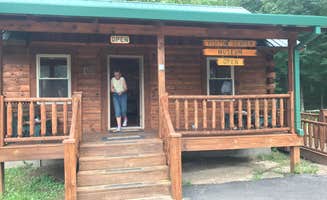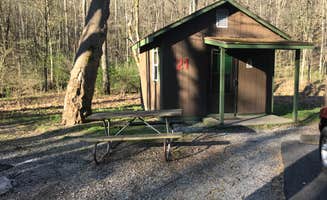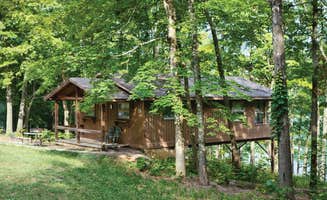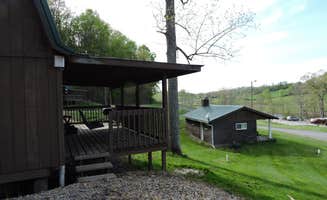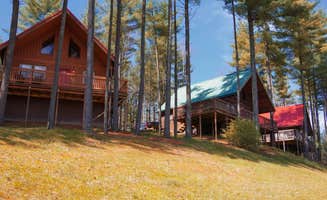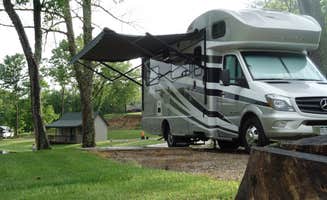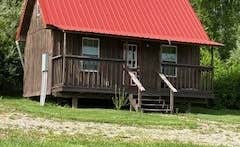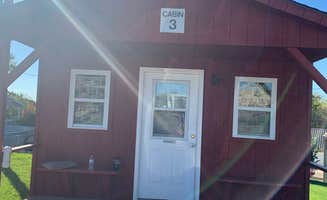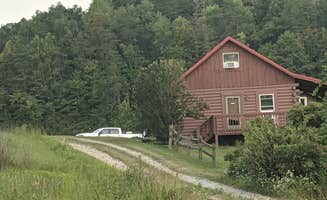Camping cabins near Marietta, Ohio sit within the unglaciated Allegheny Plateau, where the region's rolling hills and valleys create distinctly wooded terrain along the Ohio River watershed. Winter temperatures typically drop to 20°F while summer months average 84°F, creating a full four-season camping experience. Many cabins remain accessible year-round, though some facilities close seasonally due to weather conditions.
What to do
Kayaking and canoeing access: River Run Campground offers boat rentals with drop-off service upstream so you can float back to camp. "They will even drop you off upstream to start your trip," reports one visitor who enjoyed the riverside sites.
Hiking trails for all abilities: Multiple marked paths connect through the wooded terrain at Lake Hope State Park, with trails featuring fern groundcover and diverse fungi. According to one camper, "Trails have difficulty drying out, so rocks and roots were muddy and slick, but still enjoyable."
Rail trail exploration: The North Bend Rail Trail passes directly by several cabin accommodations, offering miles of flat, converted railroad paths for walking and cycling. "This humble campground is located on the 'Haunted' North Bend Rail to Trail. It was easy check in with a friendly staff," notes one visitor who recommends bringing a bike.
Historical sites: Explore regional iron production history at Hope Furnace near Lake Hope or visit the abandoned Moonville Tunnel. As one visitor explained, "Lake Hope gave me a new way to experience an area I grew up very close to... We were in Wayne National Forest and right next to the infamous Moonville tunnel."
What campers like
Riverfront cabin sites: Cabins positioned along the Hughes River at River Run Campground offer direct water views. "We were at site 13, right on the water. Check-in was easy and the staff was very friendly! Plenty of ice and firewood at the store and a cute little gift shop," notes one reviewer.
Personal hospitality touches: Riversedge Campground offers unexpected amenities not commonly found at larger facilities. One camper shared, "Our tent was right on the river and Kelli was the best host ever! On our last day she brought us warm cinnamon rolls and coffee. We enjoyed them by our fire as we watched the mist gently float over the water."
Quiet weekday availability: Many cabin locations experience minimal midweek traffic, allowing for greater privacy. "Each time I have stayed at Lake Hope State Park, I have marveled at why there are only a few stray campers in a state park of 190 sites. Granted...I am usually camping during the week...but its a ghost town," reports one happy visitor.
Specialized cabin themes: Unique cabin experiences like those at Bigfoot Ridge offer themed accommodations. "This yurt is 100% Bigfoot themed and has all the essentials including a shower house with laundry, a creek, and an amazing bed," explains one visitor who appreciated the distinctive lodging option.
What you should know
Limited cabin availability: Many smaller operations like Bigfoot Ridge have just a few units available, requiring advanced planning. The facility has only two cabin units total according to their listing information.
Varied bathroom facilities: Most park cabins require short walks to centralized shower facilities, while some have only pit toilets. "Bathrooms are vault style and very old so you can imagine it's hard to clean/keep clean. I do like they have water fountains with faucets every 10-15 sites," notes a camper at Forked Run State Park.
Pet policies differ significantly: Some locations welcome pets while others prohibit them entirely. Bigfoot Ridge does not allow pets in their themed cabins, while sites at River Run are more accommodating to animal companions.
Site elevation and levelness: Many cabin and tent sites throughout the region sit on sloped terrain. According to one visitor at Forked Run, "Sites are small back in, we stayed in loop two site 69 with great shade and electric. Toilets are vault style and very old."
Tips for camping with families
Beach access importance: Burr Oak State Park offers family-friendly swimming options beyond cabin amenities. "Campers can rent pontoons or enjoy a day kayaking the lake, or swimming on the beach," mentions a reviewer who grew up using the facilities.
Wildlife viewing opportunities: Early morning cabin stays often allow wildlife sightings. "Winding down to River Run, deer in abundance were lining the roadway, so use care," notes one visitor describing the approach to their cabin.
Playground proximity: Several campgrounds feature play areas near cabin clusters for children. At Mountwood Park Family Campground, "There are a few permanents there but we had it all to ourselves... Went for a hike on the park side around the lake. Several trails," reports a visitor who noted the park's recreational options.
Nature programs: Some parks offer educational programs led by naturalists. "The naturalists feed hummingbirds at the nature center. They pull the feeders for awhile leading up to a 'Feed the Hummingbirds' program. So cool! The birds come right to you!" shares a Lake Hope visitor.
Tips from RVers
Limited hookup considerations: Water access points are sometimes shared between multiple sites rather than individual connections. "No water hookups, but a place to fill your tank behind water fountains. Camping is deserted pretty much on weekdays," explains a Forked Run camper.
Site length limitations: Many older campgrounds have shorter pads unsuitable for larger rigs. "The RV sites were a bit narrow, but otherwise nice and shaded," notes a Lake Hope visitor, while another mentioned, "Some of the back in sites are REALLY short so we changed our originally reserved spot once we got there."
Cell service variability: Digital connectivity fluctuates widely across the region's cabin locations. "No internet or phone service so great to disconnect," reports a Lake Hope visitor, highlighting the opportunity to unplug.


